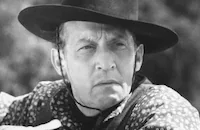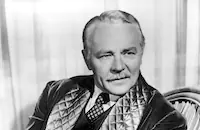Filmmakers have been adapting Lewis Carroll's
Alice's Adventures in Wonderland almost since the invention of cinema itself. The popular new version by director Tim Burton has initiated a review of the more salient attempts, such as the acclaimed 1966
Jonathan Miller BBC version. Walt Disney's 1951 release is not considered one of his better animated features, but all versions struggle with the challenge of effectively translating the story's mischievous verbal games into visual terms.
Almost forgotten in the list of notable
Alice in Wonderland adaptations is a relatively lavish Paramount production from 1933. Director Norman Z.McLeod was later known for
Topper movies and comedies with Danny Kaye and Bob Hope; here he manages an episodic pageant featuring more than twenty
Paramount stars and contract players. The cast rundown is covered in a three-minute title sequence that turns storybook pages to introduce each major character. In the movie that follows most of the stars wear rigid masks that render them anonymous. Unless one can pick out the stars by sound, the prologue isn't much help. The distinctive voices of top-billed Cary Grant, Gary Cooper and W.C. Fields' stand out plainly enough, while Edward Everett Horton and Edna May Oliver are among the few stars that don't wear masks. But film fans with sharp memories will be the only ones to identify talents like Charles Ruggles, Ned Sparks, Jack Oakie and Roscoe Ates (a 'stuttering' comic with a big role in Tod Browning's
Freaks). Paramount's
Alice in Wonderland might make a good quiz game for film buffs.
The script by co-screenwriter Joseph L. Mankiewicz shows respect for the original by staying close to Lewis Carroll's text where possible. Most versions of
Alice convey the absurdist spirit of the Mad Tea Party, which lends itself to the form of a blackout skit. Alice (pretty Charlotte Henry) finds ordinary conversation impossible when the Mad Hatter (Edward Everett Horton) willfully misconstrues all that she says and disrupts the proceedings by walking on the table. The pattern is set for poor Alice: none of her questions merits a straight answer, and usually not even a civil one. On a couple of occasions Alice's inquiries are interrupted by recitations, as when we hear the story of The Walrus and the Carpenter, illustrated by an animated cartoon. Alice also meets Carroll's full gallery of domineering women: the White Queen (Louise Fazenda), the Red Queen (Edna May Oliver) and the Queen of Hearts (May Robson).
The co-writer and art director is the brilliant production designer William Cameron Menzies, who masterminded the look of
Gone with the Wind, For Whom the Bell Tolls and the silent
The Thief of Bagdad. Menzies devises ingenious special effects for Alice's entrance into the "other world" beyond the looking glass, here a mirror placed over an ornate Victorian fireplace. The scenes showing Alice growing larger and shrinking smaller by drinking elixirs and eating cakes are particularly effective. As in the original story, she becomes so small that she swims in her own tears. Rear projection and multiple sets built at different scales show Alice frustrated by a doorway that has suddenly become much too small to admit her. When Alice shoots upward in height Menzies uses an optical trick that makes the girl appear to stretch, like one's reflection in a funhouse mirror. It was actually in another book that Alice entered the magic world through a looking glass. Menzies and Mankiewicz have their Alice fall down a rabbit hole as well.
The bulk of Alice's encounters with magical creatures are filmed on conventional stage sets that look like artificial theatrical work. Some sets, like a forest where Alice meets the White Knight, are augmented by matte paintings. The numerous character costumes also imitate the look of original illustrations, especially some of the more grotesque ones. Alice comes upon an insane household with an angry Cook (Lillian Harmer) and a Duchess (Alison Skipworth) who won't stop spanking her baby (Billy Barty). Both women wear distorted masks with oversized features that make them look like figures in a nightmare. Jack Oakie and Roscoe Karns portray Tweedledum and Tweedledee in more grotesque masks. Other characters are more conventionally represented by partial puppets -- the Caterpillar (Ned Sparks); the Cheshire Cat (Richard Arlen) and W.C. Fields' Humpty Dumpty. Cary Grant's melancholy Mock Turtle has a head that, staying true to a vintage drawing, looks almost exactly like a cow. Comedienne Polly Moran is stuck trying to make an impression while in full costume as a Dodo Bird.
Paramount's Alice is better than most, with Charlotte Henry making a spirited storybook heroine. Tim Burton altered the tale to allow Alice to be a young woman, whereas Paramount simply cast a nineteen-year-old in the role of a small child. The script shifts the opening from a picnic under the trees to a stuffy sitting room, where Alice is quickly established as a bored girl with a big imagination. She isn't a bit frightened by her ability to pass through the mirror. As per the story, the unflappable Alice is merely inconvenienced by nightmarish transformations, as when a bawling baby turns into a pig. She does lose her temper once or twice, but reacts to weird occurrences, hostile creatures and royal threats of death as if she knows everything around her is an illusion. Invited to a game of croquet, Alice does her best to play using a real flamingo as a mallet.
Mankiewicz and Menzies augment the book's all-a-dream ending by plunging Alice into an accelerating montage of madness. What little logic that exists in Wonderland is dissolved into fast cuts of agitated characters. When last seen before the transition Alice is being throttled at a banquet table. Menzies would revisit this cutting pattern twenty years later for his science fiction film
Invaders from Mars. The juvenile hero of that film experiences a similar "twisted reality" nightmare adventure, that likewise ends with a fragmented, kaleidoscopic dream montage.
Universal's DVD of
Alice in Wonderland is a fine-quality B&W transfer of film elements in excellent condition, with very clear audio. Film music
aficionados will enjoy hearing Dimitri Tiomkin's lively score, only his second full credit after contributing stock music and ballet bits for a number of movies. The disc contains no extras.
To order
Alice in Wonderland, click
here. To explore more adaptations of Lewis Carroll's novel, click
here.
by Glenn Erickson













































